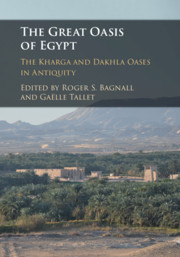Book contents
- The Great Oasis of Egypt
- The Great Oasis of Egypt
- Copyright page
- Contents
- Figures
- Tables
- Contributors
- Preface
- 1 Introduction
- Part I Living in the Oasis: Humans and the Environment
- Part II Managing the Oasis
- Part III Trade and Mobility in a Connected Environment
- Part IV An Oasis Culture?
- Bibliography
- Index of ancient people
- Index of places
- General index
Part I - Living in the Oasis: Humans and the Environment
Published online by Cambridge University Press: 12 July 2019
- The Great Oasis of Egypt
- The Great Oasis of Egypt
- Copyright page
- Contents
- Figures
- Tables
- Contributors
- Preface
- 1 Introduction
- Part I Living in the Oasis: Humans and the Environment
- Part II Managing the Oasis
- Part III Trade and Mobility in a Connected Environment
- Part IV An Oasis Culture?
- Bibliography
- Index of ancient people
- Index of places
- General index
Summary
The comparison of two small oases of the Kharga and Dakhla depressions, in the Western Desert of Egypt, confirmed that spring-fed oases have been attractive after the onset of aridity, ca 4500 BC, but irrigated agriculture has not been proved yet before the Intermediate Period. Irrigated areas were suject to harsh constraints despite the wealth of underground water during millennia: wind-induced dune shifting and soil erosion in Amheida and El-Deir, while flash floods destroyed most of the El-Deir oasis during the Roman period. Recovery was more difficult because artesian springs, which relied on water stored during the wet phase of the Holocene, were progressively exhausted by irrigation practices and could no longer compensate for the drying up of the oasis environment. If natural factors are not the unique causes of economic decay in the oases, they may have some responsibility in the progressive abandonment of agriculture during the third and fourth centuries. Amheida disappeared to the benefit of El-Kasr fortress, while El-Deir retained some importance for caravan trade between Hibis and the Nile Valley thanks to a well secured by a newly built fortress from 288 to the sixth century AD.
Keywords
- Type
- Chapter
- Information
- The Great Oasis of EgyptThe Kharga and Dakhla Oases in Antiquity, pp. 15 - 80Publisher: Cambridge University PressPrint publication year: 2019

